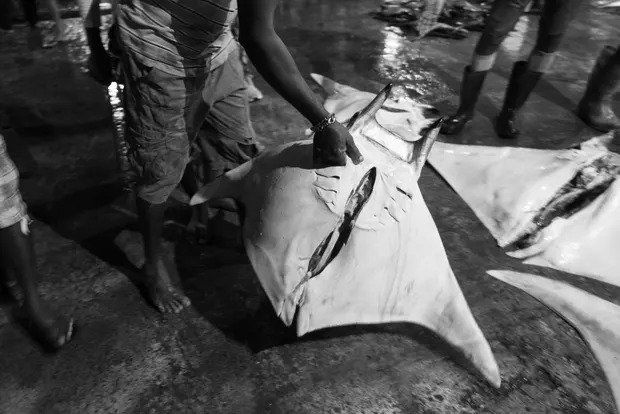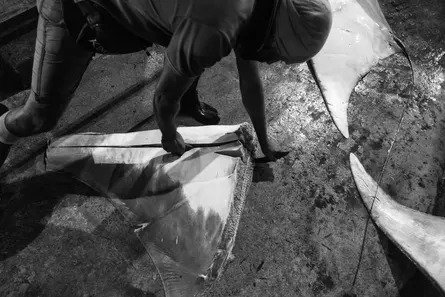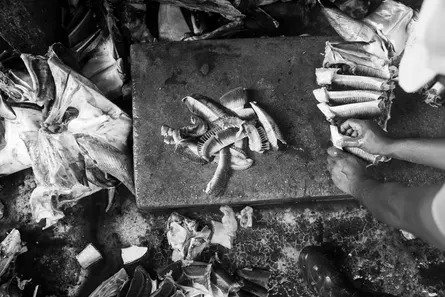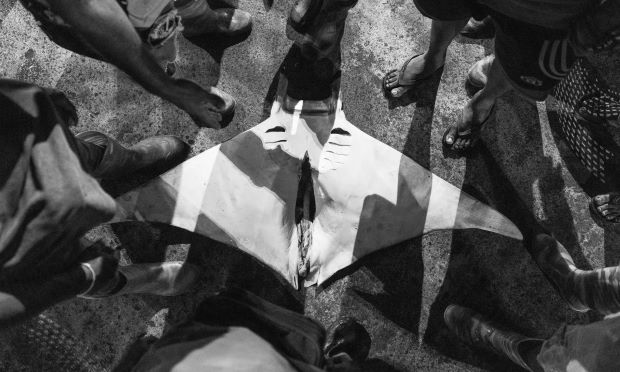It’s not like chicken farming’: why manta rays are chopped up in Sri Lanka
By Zinara Rathnayake
COLOMBO – Every morning, starting at 3.00 a.m., Lakshan hacks up manta rays. A wholesale buyer who plies his trade at Sri Lanka’s largest fish market, in the city of Negombo, just north of Colombo, he jostles with fishers offloading their catches. His business is primarily to find fresh tuna but he also buys 700kg (1,540lb) of manta and devil rays every day.
He doesn’t want the ray’s meat, which most Sri Lankans don’t eat. Instead, he’s after the gill plates: cartilage that helps manta and devil rays filter out microorganisms in ocean waters.
In a courtyard across from the market, Lakshan dries the gill plates on a corrugated iron board. Then he sells them to another trader for as much as $130 (£104) per kilo. It seems a high price, but Lakshan (who gave only his first name out of concern for his trade) needs 5kg of fresh gill plates for every kilo of dried ones. He has only a vague idea what happens to them afterwards. “We heard they sell it to the Chinese because they eat them,” he says.
Dried gill plates are indeed often sold in medicine and dried seafood markets across east Asia, but are not used in traditional Chinese medicine. The growing demand for ray gill plates stems from market vendors using them to make soup that they tout a remedy for various health issues. The conservation charity Manta Trust calls these gill-plate concoctions “a pseudo-remedy” that has “no basis in medical science”.
The demand for gill plates has generated a sprawling cottage industry. Small-scale fisheries across Sri Lanka kill manta and devil rays (collectively known as mobulids), including endangered and vulnerable species, just to export their gill plates. A recent study showed that more mobulid rays are caught in Sri Lanka alone than the annual global catch across large industrial purse seine fisheries (huge operations that use curtain-like nets to scoop up marine life by the tonne). Their sizes are also declining, the study says.
Most mobulid species are classed as endangered, which means – according to the International Union for Conservation of Nature’s criteria – their populations has reduced by between 50% and 70% in the past decade. Meanwhile, the number of mobulids being caught continues to grow, with India, Indonesia and China the biggest culprits, feeding a thriving trade centred in Guangzhou, China, and Hong Kong.
Sri Lanka fishers don’t specifically target mobulids. Instead, the rays get entangled in gillnets used to catch yellowfin tuna, billfish and sailfish. Most Sri Lankans don’t eat them, though some add dried ray meat to curry; there’s little to no demand for the fresh meat.
This meant fishers used to release manta and devil rays back to the sea, but the lucrative gill plate trade has changed that. “Sometimes fishers used to cut off their heads and toss them out in the seas, because they thought that buyers wanted the meat,” says Daniel Fernando, the co-founder of the Blue Resources Trust, a non-profit marine research institution. “But traders didn’t want the meat. They wanted gill plates, which are in the head.”
The trade in plates provides much-needed additional income. Last year, Sri Lanka’s economy crashed, dragging many families into poverty. In its worst economic crisis since independence, the country ran out of basics such as food, cooking gas and fuel. Many people are still struggling to put meals on the table, and the World Food Program reported in February that 32% of households remained food-insecure. For fishery workers like Lakshan, gill plates bring much-needed income.
Manta rays are one of the most intelligent species of fish, with a brain up to 10 times larger than that of a whale shark and more highly developed areas for learning, problem solving and communicating. They are playful, curious and are thought to be able to recognize themselves in mirrors, a sign of self-awareness usually limited to the great apes, cetaceans and elephants.
Trading rays is not illegal, although in 2014 the Convention on International Trade in Endangered Species of Wild Fauna and Flora (Cites) brought in stronger protection for manta rays, and the international trade in their meat, gills and fins is supposed to be accompanied by permits and certificates confirming that they have been harvested sustainably and legally.
However, the UN’s Bonn Convention stipulates that the animals should not be captured for commercial purposes. Sri Lanka is also signed up to the Indian Ocean Tuna Commission, which requires that its members not retain any mobulid catch.
Sri Lanka itself has no legal framework to protect manta and devil rays. It has stopped issuing export permits but there are no national protections, Fernando said. Periodically, customs agents will stop shipments of gill plates being illegally exported, but the trade is persistent: in 2020, authorities at Hong Kong airport seized 300kg of manta ray gill plates worth $116,000, coming from Sri Lanka.
As fishing boats proliferate across the Indian Ocean, mobulids are under pressure. They’re particularly vulnerable biologically to overfishing: they have slow reproduction cycles, with young female mantas taking 10-15 years to mature sexually, and giving birth to just one pup every two or three years. “Their population can collapse in a very short time,” Fernando says. “Things will appear to be fine for a few years, and then, suddenly, they can pretty much get wiped out.”
He emphasizes that the problem is not limited to Sri Lanka. “These rays don’t respect political boundaries – they go in and out of Sri Lankan waters. It’s a regional issue, if not global. Action of one country is not sufficient.”
The organization is calling for governments to join in declaring protected areas for rays and their habitats to reduce bycatch, and to educate fishers about safely releasing juveniles back into the ocean to improve their chance of survival.
Replacing the use of gillnets – vertical walls of netting used to trap fish – with properly managed sustainable fishing methods such as longlines (miles-long lines with baited hooks) would also help, but the transition could take a long time as gillnets are the main method used by small fisheries.
Rays don’t have that time, Fernando says: their stocks are falling fast. He acknowledges that locals rely on them for income but points out: “We are not putting fish in the ocean and harvesting them. It’s not like chicken farming.
“Ideally, we should’ve looked into protecting them about four decades ago, to ensure they are caught sustainably, but we’ve waited so long that they now face imminent collapse,” he says. “We are going to have to make some very difficult decisions.”



-This article was originally featured on theguardian.com/Pix Jonathan Browning/theguardian.com



Comments are closed, but trackbacks and pingbacks are open.